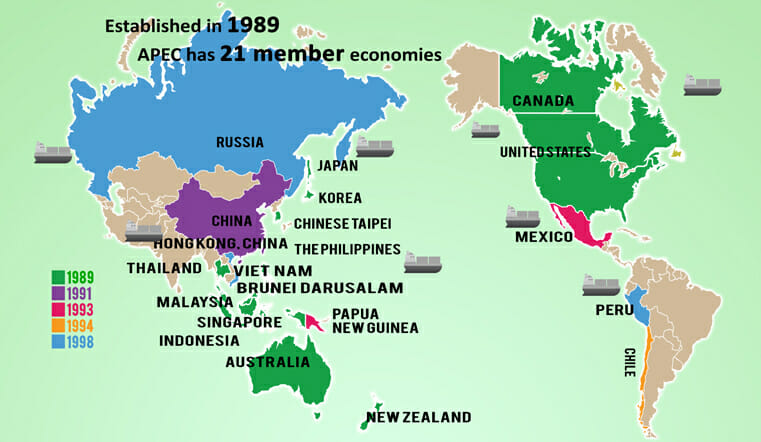Over the past couple weeks there’s been a profusion of rumblings throughout both business media and international news outlets regarding the 2014 Asia-Pacific Economic Cooperation Forum, otherwise known as APEC. The annual summit, hosted this year in Beijing, China, gives representation to 21 Pacific-rim countries with a combined GDP of over $16 trillion and carrying out 44% of world trade. Therefore, it’s prudent to ask what exactly is APEC, its negotiation results in last week’s meeting, and how will it impact global business in 2015?
Hosting the most dynamic and fastest growing nations on Earth, APEC functions as an economic cooperation vessel amongst the world’s top leaders in the Pacific-rim region. Over the past decade APEC has been the primary facilitator of economic advances and cooperation amongst member nations. The primary roles of the summit encompass trade liberalization, improving business facilitation, and deepening regional economic and technological cooperation.

Although this year’s week-long meeting was attended by some of the world’s top political leaders including President Obama and China’s President Xi Jinping, the meeting’s focus was not about pointing fingers and attempting to manage rocky political relations. Rather, the summit was utilized to temporarily push political agendas to the wayside in order to concentrate efforts on achieving mutual economic gain through open dialogue and discussion. In contrast to what many observers believed to be a meeting that would produce few tangible results and lots of questions the summit created some major developments in Sino-American economic cooperation. Pay attention, doing business with China is on its way to getting a lot better in 2015.
APEC 2014 primary impacts on global business:
China will contribute $40 billion to set up a “Silk Road” infrastructure fund to boost connectivity across Asia
The implications for this announcement are major for both Chinese and foreign businesses alike. The goal of the Silk Road initiative is to build roads, railways, ports and airports connecting Central Asia and South Asia to Mainland China. According to President Xi, the new infrastructure framework will accommodate the needs of several countries and be utilized for both land and sea-related projects. Although it’s not absolutely clear when the fund’s operations will start or where the project will begin, one thing is clear for sure: China is openly welcoming its neighboring countries to get on board the train with China’s development.
A cross border law enforcement network will be set up to strengthen transnational anti-corruption cooperation in the region
Corruption is a major obstacle to economic development and increases the cost of doing business. “APEC members have pledged to eliminate corruption through extradition and judicial assistance, and adopt flexible measures to recover the proceeds of corruption within the law of the APEC economies.”
Extension of visa validity between China and the U.S.
Up until last week, the maximum length for student, business, and tourist visas was one year. However, as of November 12th, the maximum visa length will change to 10 years for tourists and businessmen and 5 years for students. “The goal of this new policy is to encourage international tourism between the U.S. and China. According to White House officials in a recent BBC article, Chinese tourists cite the strict visa policies as the second most important factor in their decision to travel to the U.S. The article also noted that although many Chinese tourist go abroad, less than 2% of travelers visited the United States.”
Expansion of the Information Technology Agreement (ITA) between The U.S. and China, eliminating tariffs on $1 trillion in global sales of IT products
The U.S. and China have succeeded in striking a deal that will allow for expansion of the ITA trade deal that will significantly cut tariffs on a multitude of high-tech goods. Due to disagreements in past years, this is the first major breakthrough of a U.S./China WTO deal in almost two decades. A sample of some the impacted products and the size of the tariff reduction they would benefit from, include:
- Next generation semiconductors – Tariffs up to 25% reduced to zero
- Magnetic Resonance Imaging (MRI) machines – Tariffs up to 8% reduced to zero
- Computed Tomography (CT) Scanners – Tariffs up 8% reduced to zero
- Global Positioning System (GPS) devices – Tariffs up to 8% reduced to zero
- Printed matter/cards to download software and games – Tariffs up to 10% reduced to zero
- Printer ink cartridges – Tariffs up to 25% reduced to zero
- Static converters and inductors – Tariffs up to 10% reduced to zero
- Loudspeakers – Tariffs up to 30% reduced to zero
- Software media, such as solid state drives – Tariffs up to 30% reduced to zero
- Video game consoles – Tariffs up to 30% reduced to zero
- An expanded ITA would also eliminate import duties on a range of additional technology products including high-tech medical devices, video cameras, and an array of high-tech ICT testing instruments
The impact of this year’s APEC summit poses to create substantial cost savings and reduce business risk exposure across many industries that have dealings with the region. China’s declared investment into trans-national infrastructure will reduce rising logistic costs and improve the overall efficiency of global supply chain networks. Additionally, for those who may be hesitant about doing business with a country that’s famous for its “guanxi” networks, China’s announcement to erect a new cross-border, anti-corruption regime is a productive step towards providing a fair playing field for regional trade and commerce. Furthermore, In addition to improving the fluidity of doing business abroad, Visa extensions will provide companies with the often much needed reduction in over-head costs. However, perhaps the most delightful victory of all is the eradication of myriad tariffs throughout several high-tech industries. This will not only enhance global trade, but will also decrease the cost of goods for both businesses and consumers alike.
As we continue to march forward into the 21st century the Sino-American business environment remains cautiously optimistic. Although U.S.-China politics are often agitated by mutual distrust and misunderstanding it’s important to acknowledge that both countries continue to put forth an earnest effort in expanding trade, alleviating regulatory restrictions, and improving global business practices through mutual cooperation. As for the result? China and the U.S. un-deniably possess the most crucial bilateral relationship in the world. If both countries continue to patiently work towards mutually advantageous economic gain the long-term results could prove to usher in a golden age of global business, something in which, everybody can benefit from.

Michelle Scheblein is China Business Analyst at BaySource Global. She has a B.A. in international business from the University of South Florida and has resided in China from 2013-2014. She can be reached at Michelle.scheblein@baysourceglobal.net




Follow Us